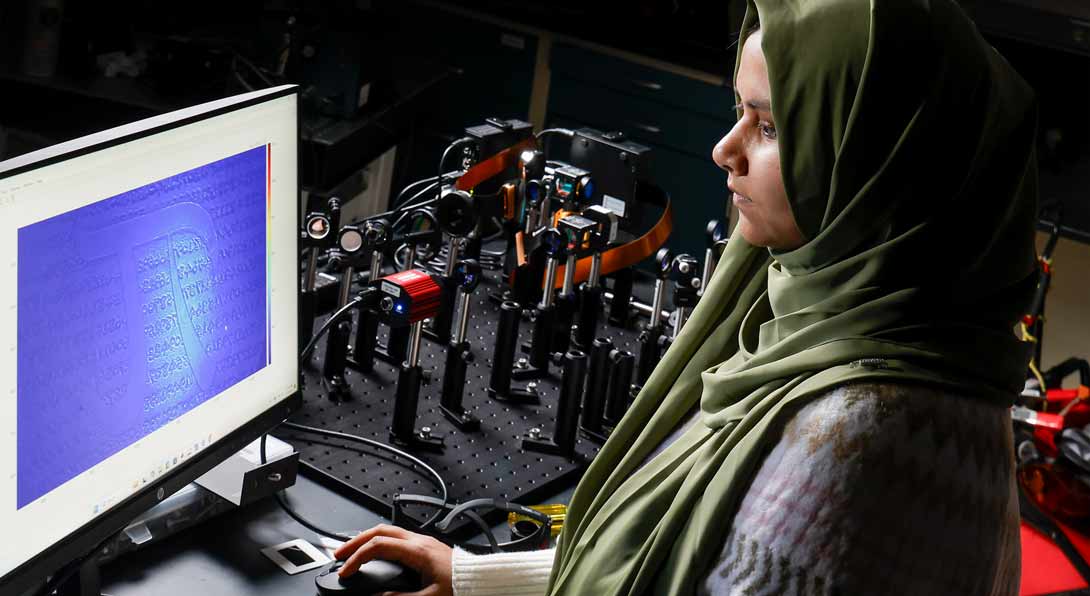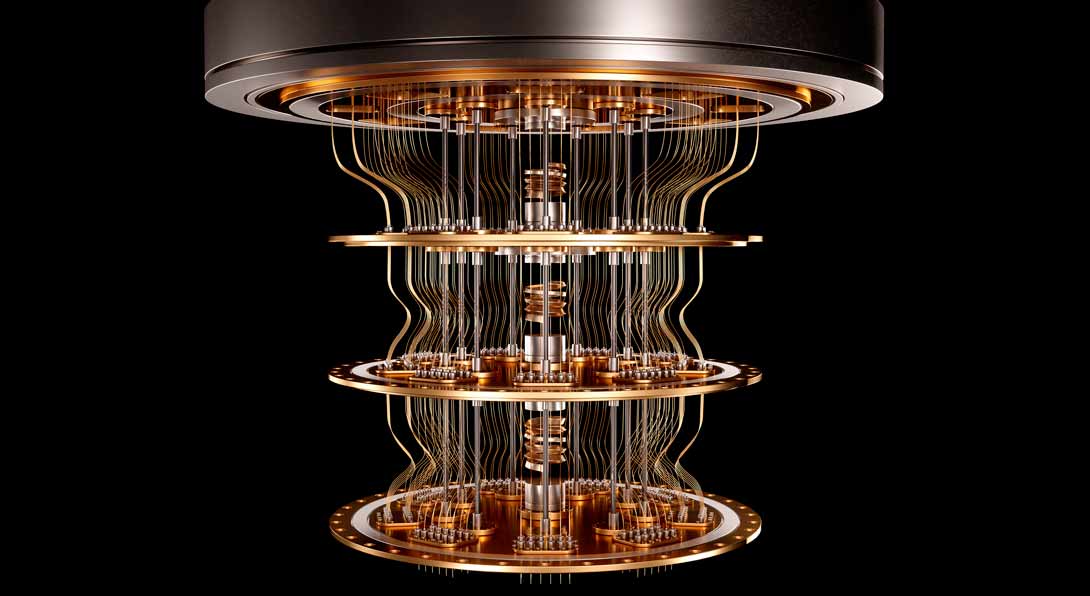The Quantum Future Unfolds

UIC faculty and students lead the push to transform computing as we know it
Over 40 years ago, the idea of a computer based on quantum principles first emerged. Today’s quantum computers are in an incipient stage, but their potential seems boundless. UIC is at the forefront of developing this wonderous technology and also helping students get in on the ground floor of this transformative field.
How quantum computers work
Quantum computers, like classical computers, use small circuits to perform calculations. The operation of these computing systems is quite different; quantum computers are able to simultaneously process exponentially more information.
Classical computers use a basic unit of data called bits, which represent one of two possible states: a 0 or 1, indicating whether a logic gate is open or closed. This can indicate a yes/no or true/false answer. This value must be assigned before a traditional computer can move on to process a successive piece of information.
In contrast, a quantum computer operates in parallel. Qubits, the unit of data used by quantum computers, don’t need a value assigned before the next calculation is performed, a process known as superposition. Unlike classical computers, where each bit is intentionally independent from one another, qubits can become entangled, and their properties are dependent on the other qubits. Information can be transferred more quickly between qubits as they work together toward a solution, and contradictory results cancel each other out, enhancing the correct results in a process known as cohesion. This makes quantum computers exponentially more powerful, as each qubit added will double a quantum computer’s processing power.
“There’s the continual speed up of what we can do classically on a computer, but we’re kind of hitting a limit there,” said Electrical and Computer Engineering Assistant Professor
Lane Gunderman. “We’re hoping that by leveraging some unique quantum properties, we can solve much harder and bigger problems.”
To date, the largest quantum computer contains around 1,200 connected qubits. Due to their increased computing power–the ability to solve optimization problems and identify patterns across large data sets–quantum computers are set to revolutionize data-intensive research, including drug discovery, materials discovery, artificial intelligence, and cybersecurity.
While quantum computers hold promise, they still present some challenges. They are more sensitive than classic computers to disturbances and interference, have low fault tolerance, and can have high rates of error when qubits decay out of their quantum state. However, a quantum computer can solve complicated problems in minutes, which will eventually break computer encryption as quantum computing grows in power.
Daniela Tuninetti
Quantum technology has the potential to revolutionize multiple fields, enabling new processing capabilities and solutions to problems currently considered unsolvable. This is expected to have a profound impact across industries, from drug discovery to provably secure communications
| Professor and ECE department head
Quantum at UIC
UIC’s electrical and computer engineering department has several faculty members specializing in quantum computing and engineering. Associate Professor Thomas Searles is researching quantum materials and metamaterials to make quantum computers more secure and efficient. Other quantum-focused faculty include Assistant Professor Zizwe Chase, who studies light-matter interactions with 2D metamaterials and 1D materials; Assistant Professor Ian Mondragon-Shem, whose research interests include phases of matter, quantum simulators, superconducting circuits, and quantum entanglement; and Gunderman, who works on the math related to how to correct mistakes during computation and maximizing the computing ability of available qubits. Condensed matter physicist Professor Adina Luican-Mayer, who specializes in quantum sensing, will join the faculty later this year.
UIC was the sixth Minority-Serving Institution selected to join the Co-design Center for Quantum Advantage (C2QA), a U.S. Department of Energy (DOE)-funded center focused on building the tools necessary to create scalable, distributed, and fault-tolerant quantum computer systems.
“The Co-Design Center for Quantum Advantage and its affiliated researchers are leaders in advancing quantum-based applications through scientific research — our partnership with the center opens up incredible opportunities for our faculty, and more importantly, our students, to partner on innovative discoveries in quantum computing, network and participate in seminars and career fairs,” Searles said. “C2QA and UIC are bringing opportunities in the field of quantum to underserved groups in Chicago that don’t exist.”
In 2023, UIC was tapped to lead a new endeavor, the ReACT-QISE Consortium. This DOE initiative includes Historically Black Colleges and Universities, Hispanic-Serving Institutions, and institutions serving predominantly female students. Searles, Chase, and Tuninetti, lead the $4.8 million initiative.
Impact on engineering and computer science students

Many UIC students have already reaped the benefits of the school’s strong commitment to and investment in quantum computing. In addition to access to local and national quantum networks, UIC has added specific courses in quantum computing.
Undergraduate Caleb Williams is the president of UIC’s Quantum Information Science Society at UIC, a club that has grown to include over 500 students. He received an undergraduate research award from the Institute for Quantum Computing in Waterloo, Canada, and expects to earn his bachelor’s degrees in electrical engineering and physics this spring.
Engineering Physics Junior Zoe Zuro was one of 17 students selected to participate in quantum science research projects through the Open Quantum Initiative Undergraduate Fellowship program. She spent last summer at Argonne National Laboratory on a project to map the photoluminescence of diamond samples to locate defects in the stones, which have applications in quantum computing and quantum sensing.
Tenyu Aikawa, an ECE master’s degree candidate in Chase’s lab, expects to earn his degree this year and already found a job in quantum. He is working for the startup Quoherent, a company aiming to develop a portable quantum computer using qubits made from crystals.
In 2023, Sanjaya Lohani, then a postdoctoral associate in Searles’ research group, won the first Brookhaven postdoctoral C2QA seed award competition for quantum information applications. The $50,000 award was for his work centered on finding classical machine learning approaches that can work in conjunction with quantum computing systems. Lohani is now an assistant professor at Southern Methodist University in Dallas.
And Alan Salari, who earned his doctoral degree this spring, wrote a book on quantum hardware—the first of its kind. He was able to find books on the fundamentals of quantum computing and software implementation but came up empty on hardware implementation. So, he wrote Microwave Techniques in Superconducting Quantum Computers, published last year by Artech House.
“Quantum computing is interdisciplinary,” Salari said. “You need to understand cryogenic techniques, microwave engineering, quantum mechanics, and quantum computing–and then you need to have deep understanding of data acquisition and experiment control.”
He hopes his guide will help the next generation of aspiring quantum engineers.